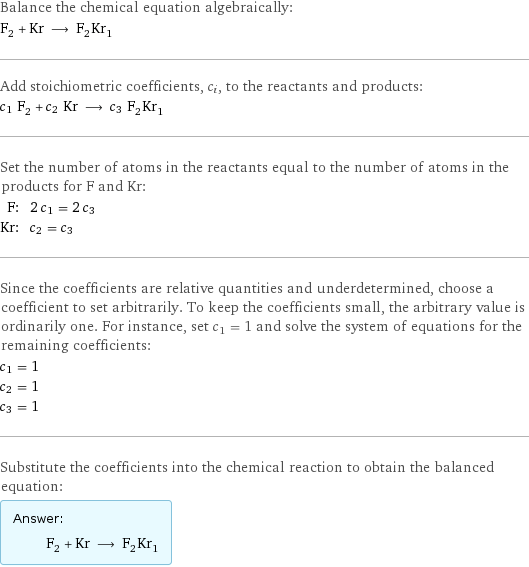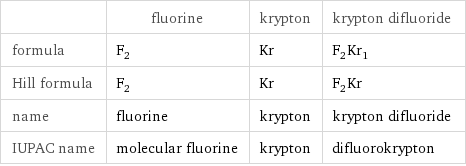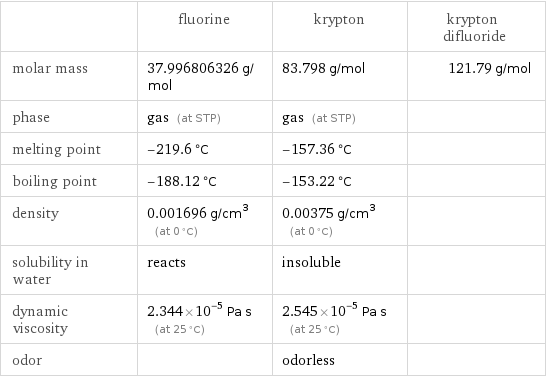Input interpretation

F_2 fluorine + Kr krypton ⟶ F_2Kr_1 krypton difluoride
Balanced equation

Balance the chemical equation algebraically: F_2 + Kr ⟶ F_2Kr_1 Add stoichiometric coefficients, c_i, to the reactants and products: c_1 F_2 + c_2 Kr ⟶ c_3 F_2Kr_1 Set the number of atoms in the reactants equal to the number of atoms in the products for F and Kr: F: | 2 c_1 = 2 c_3 Kr: | c_2 = c_3 Since the coefficients are relative quantities and underdetermined, choose a coefficient to set arbitrarily. To keep the coefficients small, the arbitrary value is ordinarily one. For instance, set c_1 = 1 and solve the system of equations for the remaining coefficients: c_1 = 1 c_2 = 1 c_3 = 1 Substitute the coefficients into the chemical reaction to obtain the balanced equation: Answer: | | F_2 + Kr ⟶ F_2Kr_1
Structures

+ ⟶
Names

fluorine + krypton ⟶ krypton difluoride
Equilibrium constant
![Construct the equilibrium constant, K, expression for: F_2 + Kr ⟶ F_2Kr_1 Plan: • Balance the chemical equation. • Determine the stoichiometric numbers. • Assemble the activity expression for each chemical species. • Use the activity expressions to build the equilibrium constant expression. Write the balanced chemical equation: F_2 + Kr ⟶ F_2Kr_1 Assign stoichiometric numbers, ν_i, using the stoichiometric coefficients, c_i, from the balanced chemical equation in the following manner: ν_i = -c_i for reactants and ν_i = c_i for products: chemical species | c_i | ν_i F_2 | 1 | -1 Kr | 1 | -1 F_2Kr_1 | 1 | 1 Assemble the activity expressions accounting for the state of matter and ν_i: chemical species | c_i | ν_i | activity expression F_2 | 1 | -1 | ([F2])^(-1) Kr | 1 | -1 | ([Kr])^(-1) F_2Kr_1 | 1 | 1 | [F2Kr1] The equilibrium constant symbol in the concentration basis is: K_c Mulitply the activity expressions to arrive at the K_c expression: Answer: | | K_c = ([F2])^(-1) ([Kr])^(-1) [F2Kr1] = ([F2Kr1])/([F2] [Kr])](../image_source/9840b74d43e7310a172ccfb9ca8731e7.png)
Construct the equilibrium constant, K, expression for: F_2 + Kr ⟶ F_2Kr_1 Plan: • Balance the chemical equation. • Determine the stoichiometric numbers. • Assemble the activity expression for each chemical species. • Use the activity expressions to build the equilibrium constant expression. Write the balanced chemical equation: F_2 + Kr ⟶ F_2Kr_1 Assign stoichiometric numbers, ν_i, using the stoichiometric coefficients, c_i, from the balanced chemical equation in the following manner: ν_i = -c_i for reactants and ν_i = c_i for products: chemical species | c_i | ν_i F_2 | 1 | -1 Kr | 1 | -1 F_2Kr_1 | 1 | 1 Assemble the activity expressions accounting for the state of matter and ν_i: chemical species | c_i | ν_i | activity expression F_2 | 1 | -1 | ([F2])^(-1) Kr | 1 | -1 | ([Kr])^(-1) F_2Kr_1 | 1 | 1 | [F2Kr1] The equilibrium constant symbol in the concentration basis is: K_c Mulitply the activity expressions to arrive at the K_c expression: Answer: | | K_c = ([F2])^(-1) ([Kr])^(-1) [F2Kr1] = ([F2Kr1])/([F2] [Kr])
Rate of reaction
![Construct the rate of reaction expression for: F_2 + Kr ⟶ F_2Kr_1 Plan: • Balance the chemical equation. • Determine the stoichiometric numbers. • Assemble the rate term for each chemical species. • Write the rate of reaction expression. Write the balanced chemical equation: F_2 + Kr ⟶ F_2Kr_1 Assign stoichiometric numbers, ν_i, using the stoichiometric coefficients, c_i, from the balanced chemical equation in the following manner: ν_i = -c_i for reactants and ν_i = c_i for products: chemical species | c_i | ν_i F_2 | 1 | -1 Kr | 1 | -1 F_2Kr_1 | 1 | 1 The rate term for each chemical species, B_i, is 1/ν_i(Δ[B_i])/(Δt) where [B_i] is the amount concentration and t is time: chemical species | c_i | ν_i | rate term F_2 | 1 | -1 | -(Δ[F2])/(Δt) Kr | 1 | -1 | -(Δ[Kr])/(Δt) F_2Kr_1 | 1 | 1 | (Δ[F2Kr1])/(Δt) (for infinitesimal rate of change, replace Δ with d) Set the rate terms equal to each other to arrive at the rate expression: Answer: | | rate = -(Δ[F2])/(Δt) = -(Δ[Kr])/(Δt) = (Δ[F2Kr1])/(Δt) (assuming constant volume and no accumulation of intermediates or side products)](../image_source/731273922e1a80d11226cd8a76507929.png)
Construct the rate of reaction expression for: F_2 + Kr ⟶ F_2Kr_1 Plan: • Balance the chemical equation. • Determine the stoichiometric numbers. • Assemble the rate term for each chemical species. • Write the rate of reaction expression. Write the balanced chemical equation: F_2 + Kr ⟶ F_2Kr_1 Assign stoichiometric numbers, ν_i, using the stoichiometric coefficients, c_i, from the balanced chemical equation in the following manner: ν_i = -c_i for reactants and ν_i = c_i for products: chemical species | c_i | ν_i F_2 | 1 | -1 Kr | 1 | -1 F_2Kr_1 | 1 | 1 The rate term for each chemical species, B_i, is 1/ν_i(Δ[B_i])/(Δt) where [B_i] is the amount concentration and t is time: chemical species | c_i | ν_i | rate term F_2 | 1 | -1 | -(Δ[F2])/(Δt) Kr | 1 | -1 | -(Δ[Kr])/(Δt) F_2Kr_1 | 1 | 1 | (Δ[F2Kr1])/(Δt) (for infinitesimal rate of change, replace Δ with d) Set the rate terms equal to each other to arrive at the rate expression: Answer: | | rate = -(Δ[F2])/(Δt) = -(Δ[Kr])/(Δt) = (Δ[F2Kr1])/(Δt) (assuming constant volume and no accumulation of intermediates or side products)
Chemical names and formulas

| fluorine | krypton | krypton difluoride formula | F_2 | Kr | F_2Kr_1 Hill formula | F_2 | Kr | F_2Kr name | fluorine | krypton | krypton difluoride IUPAC name | molecular fluorine | krypton | difluorokrypton
Substance properties

| fluorine | krypton | krypton difluoride molar mass | 37.996806326 g/mol | 83.798 g/mol | 121.79 g/mol phase | gas (at STP) | gas (at STP) | melting point | -219.6 °C | -157.36 °C | boiling point | -188.12 °C | -153.22 °C | density | 0.001696 g/cm^3 (at 0 °C) | 0.00375 g/cm^3 (at 0 °C) | solubility in water | reacts | insoluble | dynamic viscosity | 2.344×10^-5 Pa s (at 25 °C) | 2.545×10^-5 Pa s (at 25 °C) | odor | | odorless |
Units
